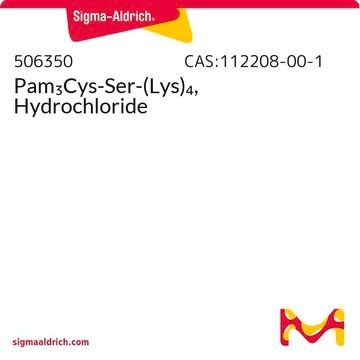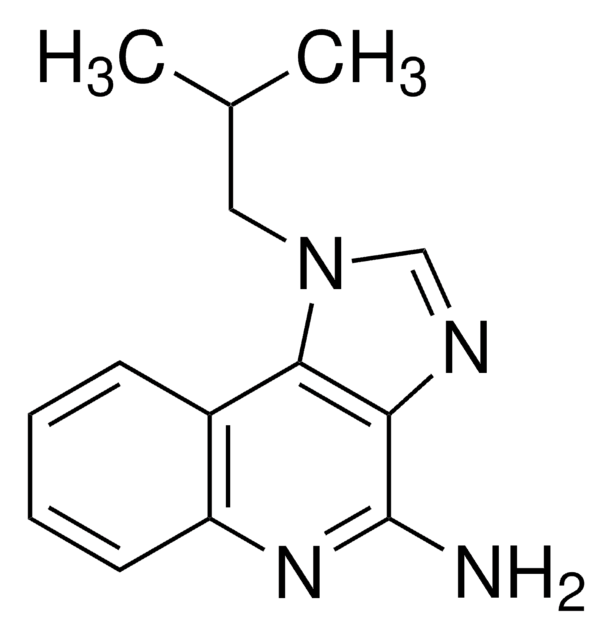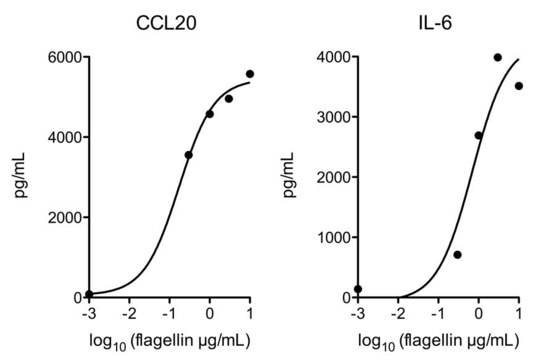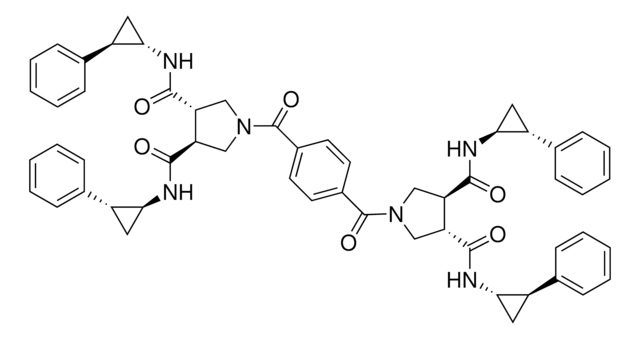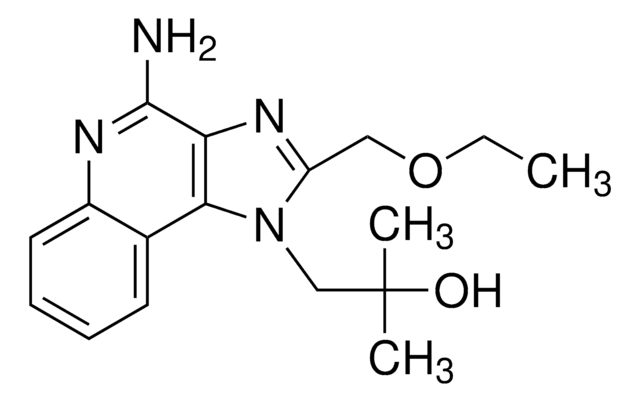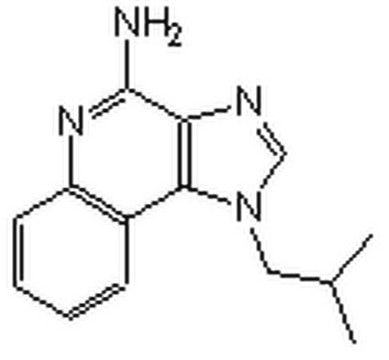5.32583
TLR1/TLR2 Agonist II, CU-T12-9
Synonym(s):
TLR1/TLR2 Agonist II, CU-T12-9, N-Methyl-4-nitro-2-(4-(4-(trifluoromethyl)phenyl)-1H-imidazol-1-yl)aniline, CUT129
Sign Into View Organizational & Contract Pricing
All Photos(1)
About This Item
Empirical Formula (Hill Notation):
C17H13F3N4O2
CAS Number:
Molecular Weight:
362.31
UNSPSC Code:
12352200
NACRES:
NA.77
Recommended Products
assay
≥98% (HPLC)
Quality Level
form
powder
manufacturer/tradename
Calbiochem®
storage condition
OK to freeze
protect from light
color
yellow
solubility
DMSO: 50 mg/mL
storage temp.
2-8°C
General description
A diphenyl substituted imidazole based compound that directly and selectively targets TLR1/2 and induces their dimerization and activates TLR1 & 2 signaling leading to NF-κB and AP-1 activation (KD = 182 and 478 nM, respectively; EC50 = 52.9 nM for TLR2 in HEK-Blue cells over-expressing hTLR2). Does not affect the dimerization of TLR2/TLR6 and exhibits poor affinity towards TLR3, TLR4, TLR5, TLR7 and TLR8. Shown to compete with Pam3CSK4 (Cat. No. 506350; Ki = 45.4 nM) for binding to TLR1/2 interface and enhance heterodimerization. Up-regulates the expression of TLR1, TLR2, TNFα, IL-10, and iNOS in RAW 264.7 macrophages in a time-dependent manner. Shown to be non-toxic up to 100 µM concentration.
Please note that the molecular weight for this compound is batch-specific due to variable water content.
Please note that the molecular weight for this compound is batch-specific due to variable water content.
A non-cytotoxic (up to 100 µM) diphenyl-substituted imidazole compound that exhibits high affinity toward both TLR1 & TLR2 (KD = 182 nM & 478 nM, respectively) and induces TLR1/2 heterodimerization, effectively completing against Pam3CSK4 (Cat. No. 506350) for TLR1/2 binding (Ki = 45.4 nM; [Pam3] = 20 mg/mL; [TLR1/2] = 80 nM). Shown to potently induce secreted embryonic alkaline phosphatase (SEAP) production from human TLR2-, but not TLR3-, 4-, 5-, 7-, 8-, transfected HEK293 (EC50 = 52.9 nM) in an NF-κB inhibitor Triptolide-(Cat. No. 645900) blockable manner via selective TLR1/2, but not TLR2/6, heterodimer activation. Reported to induce comparable NF-κB-dependent reporter transcription as 100 ng/mL Pam3CSK4 when administered to human macrophage U937 cultures at 5 µM concentration (24 h) and effectively trigger NO production in both murine Raw 264.7 and primary rat macrophage cultures (ECmax = 1.2 & 0.4 µM, respectively; 24 h), blockable by TLR1/2 antagonist CU-CPT22 (Cat. No. 614305), but not TLR4 antagonist TAK-242 (Cat. No. 614316 & 508336). Likewise, both CU-T12-9 and Pam3CSK4 (1 µM & 50 ng/mL, respectively) are demonstrated to induce similar time-dependent induction of TLR1, TLR2, TNF-α, iNOS, IL-10 mRNA in Raw 264.7 cells.
TLR1/TLR2 Agonist & CU-T12-9
Biochem/physiol Actions
Primary Target
TLR1/TLR2
TLR1/TLR2
Reversible: yes
Warning
Toxicity: Standard Handling (A)
Reconstitution
Following reconstitution, aliquot and freeze (-20°C). Stock solutions are stable for up to 3 months at -20°C.
Other Notes
Cheng, K., et al. 2014. Manuscript in preparation.
Legal Information
CALBIOCHEM is a registered trademark of Merck KGaA, Darmstadt, Germany
Storage Class
11 - Combustible Solids
wgk_germany
WGK 3
flash_point_f
Not applicable
flash_point_c
Not applicable
Certificates of Analysis (COA)
Search for Certificates of Analysis (COA) by entering the products Lot/Batch Number. Lot and Batch Numbers can be found on a product’s label following the words ‘Lot’ or ‘Batch’.
Already Own This Product?
Find documentation for the products that you have recently purchased in the Document Library.
Our team of scientists has experience in all areas of research including Life Science, Material Science, Chemical Synthesis, Chromatography, Analytical and many others.
Contact Technical Service